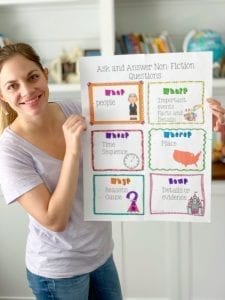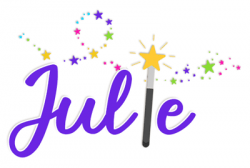Many teachers and students cringe when it comes to Common Core reading passages. When thinking about them, their minds immediately go to boring standards based test prep. I’m here to tell you, teaching and learning about Common Core reading passages and answering standards-based questions does not have to be tedious or boring. It can actually be fun and fulfilling! Keep reading to learn how to teach Common Core Reading Standards in a fun way that engages readers at all levels.
To get the best experience out of each Common Core reading lesson, it is most effective to initially teach each standard in isolation. Many students benefit from explicit instruction, and they tend to be more successful when they are given steps to follow and know what to expect. It may seem time consuming to teach each standard in isolation, but if you create an effective learning schedule that allows enough flexibility for each student to find success, you can maximize learning and make the time worthwhile.
The following schedule is an example of how I teach each student how to answer comprehension questions for each individual Common Core reading standard. (Of course, the time spent for each lesson depends on the complexity of the standard and the students’ prior exposure to the standard.)
Day 1: Model the Common Core Reading Standard (Approx. 15 min.)
1. First, introduce the Common Core standard. Show students a poster of the steps you take to help you attack the specific standard in any reading passage. (I create the poster before and may leave some blanks for students to fill in.) I also give students a “mini” anchor chart for their journal. Furthermore, a good tip is that you can help keep the student’s engagement by leaving blanks

2. Next, model how to read a Common Core reading passage and answer questions based on the specific standard. You can put a passage on a projector or on a piece of chart paper. I usually just print the passage very big and paste it on a poster because it is helpful to have the poster for reteaching. Also, students constantly refer back to the poster. Be sure when you model how to answer the questions, you are going through the steps. Above all, make sure you model exactly what you think. (NOTE: If you are using my Nonfiction Common Core Reading Comp. packets, you can pick one passage for the model. Model answering 2-3 questions. Save the rest of the questions for the We-Do Together portion of the lesson.
*Remember- Modeling is not the time for students to participate orally in the lesson. You should not be asking for any student input during the lesson.
3. Closing: Before sending kids off for independent reading, centers, and small groups, close the lesson by reviewing what was learned. On the first day, I may close the lesson by asking random students to repeat the steps back to me. (I also let them use their journal to refer to the steps. Above all, keep in mind that it will take a lot of practice throughout the week for students to internalize the steps.)
Day 2: Guided Practice- We Do Together

1. First, have students bring their journals to the gathering place and open them to the anchor chart from the day before. Then display your anchor chart and call on individual students to review the steps they need to follow to master the standard.
2. Next, display a passage on a projector or poster (you can use the same one from the day before since you saved some of the questions that go with it.) Then reread the passage. Tell students that today, you would like their help. With the students now prepared to engage, you can work as a class to go through the steps to answer the remaining questions. Make note of students who are quickly grasping the process and of students who need more support.
*If a lot of students are struggling, work with a lower level passage. Sometimes you may even need to go back to modeling and thinking out loud. I taught in an inclusion class with students who were two or more grade levels behind. Often times, I would continue to work with and support these students through the “we do with a partner” day. It is also very important to differentiate passages. If you have students who are well below grade level, you can use passages for 1st grade. You can read more about scaffolding and differentiation below.
3. Closing: On day two, I challenge students to practice the new Common Core standard during their independent reading. After small groups and centers, I ask for one to two student volunteers to share how they used the new standard. In order to participate, they must have something written in their journal or on a sticky note.
Day 3: Guided practice- We Do With a Partner
1. Review the steps students need to follow to master the Common Core reading standard.
2. Next, students who are ready will work with a partner on a new passage. Students who are not ready will work on a new passage with the teacher.
3. Closing: On day three, I ask students to practice the new Common Core reading standard in their independent reading. After small groups and centers, I ask for one to two volunteers to share how they used the new standard. They must have something written in their journal or on a sticky note.
Day 4: Independent Practice
1. First, review the steps students need to follow to master the standard.
2. Next, students will practice with the level of support they need.
5. Closing: On day four, I expect students to practice the new standard in their independent reading. After small groups and centers, I choose two random students to share how they used the new standard. At this point, everyone must have something written in their journal or on a sticky note.
*While it sounds chaotic to have students working on different things, if you follow this routine every week, students will get the hang of it quickly. It is also important to have set rituals and routines in place.
Day 5: Independent Practice (Everyone)
1. Review the steps students need to follow to master the standard.
2. Around day five, I have the entire class practice on a passage independently. I differentiate Common Core reading passages. Students who started independent practice on day four get a more challenging passage (if they were successful), but students who were still struggling the day before get a passage on their independent reading level.
*Walk around the room and ensure to check on each child multiple times. If possible, try to check off their work while circulating. This instant feedback is very helpful to students. It also helps you catch any misconceptions immediately and gives you time to confer with them quickly.
3. Closing: On day five, I expect students to practice the new standard in their independent reading. After small groups and centers, I choose two random students to share how they used the new standard. Again, everyone must have something written in their journal or on a sticky note.
Day 6: Independent Practice Continued
1. Review the steps students need to follow to master the standard.
2. Students finish and correct their independent work from the day before.
* It is very important to review student work as soon as possible. Consequently, give students feedback immediately and guide them towards making corrections.
3. I may pull my lowest group if they need more support. I may also rotate groups of students with similar mistakes on passages or similar reading levels.
4. Closing: From here on out, I expect students to practice the new standard in their independent reading. After small groups and centers, I choose two random students to share how they used the new standard.
5. Exit Ticket: All students must give me a sticky note or their journal to show me how they practiced the standard in their independent reading. It is important to give feedback to students as needed.
*Sometimes I continue Independent practice for 4 days. If any students are struggling, the extra time gives me more opportunities to meet with small groups. Moreover, it gives my higher students more time to practice the standard with higher level text.
Day 7: Assessment (If ready)
1. If most students mastered their independent work, I assess the skill the following day. However, if there are still a lot of students struggling, I continue to reteach and provide support until they are independent.
I typically give the same assessment to all my students because they will be expected to take a standardized assessment at the end of the year. Even if they are reading below level, it is important for students to have experience with how to access higher-level texts. I will give a lower-level assessment if I know the child has no chance of success with the grade-level assessment.
Day 8- Review Assessment
1. Grade the assessment, but do not write the correct answers. Then review the assessment as a class, or in small groups. I typically like to review assessments in small groups because students tend to pay better attention and grasp and correct their mistakes. It helps to rotate through small groups quickly, and I like to group students who got the same questions wrong.
It is important to hold students accountable for correcting their mistakes. We all know, people want to take shortcuts if possible; however, if you consistently hold your students accountable for correcting their mistakes, you will find they take more time on their work. Students quickly realize that it ends up making more work for them when the make careless mistakes.
I recommend scaffolding the passage levels you use. On the first day of independent practice, I give all students a passage on the low end of the Lexile range. I try to grade student work as quickly as possible to give immediate feedback. I would often grade as students turned their work in, right in front of them, or rotate around the class giving feedback. It is important to give clear feedback about how they are implementing strategies of using text evidence and not just mark answers “right” or “wrong”.
If students answer a question incorrectly or incompletely, it is important to have them fix it so they learn from their mistakes before moving on. Once students are successful with a lower level passage, I continue to assign more passages at a higher level.
Some students would end up completing 4-5 passages and show mastery at the higher end of the Lexile range, while some of my students reading at a lower level would only complete 1-2 passages.
For any students who are reading well out of grade level, it is important to give them a text at their level. I would provide more support to these students in a small group, and give them more independence and increase text levels as they had more practice.
Many students who are reading below grade level are still able to learn to access grade-level text with enough modeling, support, and scaffolding; however, if you have students who are at the very beginning stages of reading, they need to have access to very simple texts, but still practice the same strategy. It is important to meet the needs of your students and differentiate so students do not become overly frustrated and shut down.
If possible, by the end of the week, I try to have all, or most students working on at least one grade-level passage. For some of my ESE kids, this would mean working with a grade-level passage at the low end of the Lexile range and only answering 2-3 explicit questions.
Where to Find Common Core Reading Resources
If you’re looking for plenty of Common Core reading passages to help your students master these standards, you can check out my bundles for 1st grade, 2nd grade, 3rd grade, 4th grade, and 5th grade here:

We strive to create resources that empower teachers and transform student success. We create skill-focused resources that promote critical thinking, enhance student engagement, and incorporate diversity. Our goal is to develop the tools teachers need to reach their students and foster a lifetime of learning.

